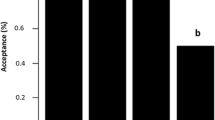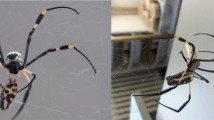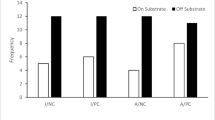Abstract
The wolf spider, Pardosa milvina, displays effective antipredator behavior (reduced activity) in the presence of silk and excreta cues from adults of another cooccurring wolf spider, Hogna helluo. However, Pardosa and Hogna engage in size-structured intraguild predation, where Pardosa may be either the prey or predator of Hogna. We tested the ability of adult female Pardosa to vary antipredator responses toward kairomones produced by Hogna that vary in size. Hogna were maintained on filter paper for 24 hr. We then presented the paper to adult female Pardosa simultaneously paired with a blank sheet of paper. One treatment had two sheets of blank paper to serve as a control. The Hogna stimulus treatments were as follows (N = 15/treatment): (1) 1 Hogna half the mass of Pardosa; (2) 1 Hogna of equal mass of a Pardosa; (3) 1 adult Hogna, 30 times the mass of Pardosa; and (4) 8 Hogna each 0.25 the mass of Pardosa. Pardosa decreased activity in the presence of kairomones from Hogna of equal or larger size, but showed no change in activity in the presence of a blank control or from a single Hogna smaller than itself. Pardosa showed a reduction in activity in the presence of cues from eight small Hogna. Pardosa avoided substrates with adult Hogna cues, but showed no avoidance response to any other treatment. These results suggest that Pardosa is showing graded antipredator behavior relative to the quantity of predator kairomones present rather than directly discriminating among the different sizes of the predator.
Similar content being viewed by others
REFERENCES
BERGLUND, A. 1993. Risky sex: Male pipefishes mate at random in the presence of a predator. Anim. Behav. 46:169–175.
CALDWELL, J. P., THORP, J. H., and JERVEY, T. O. 1980. Predator-prey relationships among larval dragonflies, salamanders, and frogs. Oecologia 46:285–289.
CHIVERS, D. P., WISENDEN, B. D., and SMITH, J. F. 1996. Damselfly larvae learn to recognize predators from chemical cues in the predator's diet. Anim. Behav. 52:315–320.
CROWL, T. A. and COVICH, A. P. 1990. Predator-induced life-history shifts in a freshwater snail. Science 247:949–951.
DILL, L. M. and FRASER, A. H. G. 1997. The worm re-turns: Hiding behavior of a tube dwelling marine polychaete, Serpula vermicularis. Behav. Ecol. 8:186–193.
FORSGREN, E. 1992. Predation risk affects mate choice in a gobiid fish. Am. Nat. 140:1041–1049.
GODIN, J.-G. J. 1995. Predation risk and alternative mating tactics in male Trinidadian guppies (Poecilia reticulata). Oecologia 103:224–229.
HEDRICK, A. V. and DILL, L. M. 1993. Mate choice by female crickets is influenced by predation risk. Anim. Behav. 46:193–196.
KATS, L. B. and DILL, L.M. 1998. The scent of death: Chemosensory assessment of predation risk by prey animals. Ecoscience 5:361–394.
LAURILA, A., KUJASALO, J., and RANTA, E. 1997. Different antipredator behaviour in two anuran tadpoles: Effects of predator diet. Behav. Ecol. Sociobiol. 40:329–336.
LIMA, S. L. 1998. Stress and decision-making under the risk of predation: Recent devElopments from behavioral, reproductive, and ecological perspectives. Adv. Study Behav. 27:215–290.
LIMA, S. L. and DILL, L. M. 1990. Behavioral decisions made under the risk of predation: A review and prospectus. Can. J. Zool. 68:619–640.
LIZOTTE, R. S. and ROVNER, J. S. 1988. Nocturnal capture of fireflies by lycosid spiderS: Visual versus vibratory stimuli. Anim. Behav. 36:1809–1815.
MARSHALL, S. D. and RYPSTRA, A. L. 1999. Patterns in the distribution of two wolf spiders. Environ. Entomol. 28:1052–1059.
MURRAY, D. L. and JENKINS, C. L. 1999. Perceived predation risk as a function of predator dietary cues in terrestrial salamanders. Anim. Behav. 57:33–39.
PERSONS, M. H. and RYPSTRA, A. L. 2000. Preference for chemical cues associated with recent prey in the wolf spider Hogna helluo (Araneae: Lycosidae). Ethology 106:27–35.
PERSONS, M. H. and UETZ, G. W. 1997. The effects of prey attack and movement on the patch residence decision rules of Schizocosa ocreata (Araneae: Lycosidae). J. Insect Behav. 10:737–751.
PERSONS, M. H., WALKER, S. E., RYPSTRA, A. L., and MARSHALL, S. D. 2001. Wolf spider predator avoidance tactics and survival in the presence of diet-associated predator cues. Anim. Behav. 61:43–51.
PUNZO, F. and KUKOYI, O. 1997. The effects of prey chemical cues on patch residence time in the wolf spider Trochosa parthenus (Chamberlin) (Lycosidae) and the lynx spider Oxyopes salticus Hentz (Oxyopidae). Bull. Br. Arachnol. Soc. 10:323–326.
PUTTLITZ, M. H., CHIVERS, D. P., KIESECKER, J. M., and BLAUSTEIN, A. R. 1999. Threat-sensitive predator avoidance by larval Pacific treefrogs (Amphibia, Hylidae). Ethology 105:449–456.
ROVNER, J. S. 1996. Conspecific interactions in the lycosid spider Rabidosa rabida: The roles of different senses. J. Arachnol. 24:16–23.
SAMU, F., TOFT, S. and KISS, B. 1999. Factors influencing cannibalism in the wolf spider Pardosa agrestis (Araneae, Lycosidae). Behav. Ecol. Sociobiol. 45:349–354.
SIH, A., 1997. To hide or not to hide? Refuge use in a fluctuating environment. Trends Ecol. Evol. 12:375–376.
VENZON, M., JANSSEN, A., PALLINI, A., and SABELIS, M. W. 2000. Diet of a polyphagous arthropod predator affects refuge seeking of its thrips prey. Anim. Behav. 60:369–375.
Author information
Authors and Affiliations
Rights and permissions
About this article
Cite this article
Persons, M.H., Rypstra, A.L. Wolf Spiders Show Graded Antipredator Behavior in the Presence of Chemical Cues from Different Sized Predators. J Chem Ecol 27, 2493–2504 (2001). https://doi.org/10.1023/A:1013679532070
Issue Date:
DOI: https://doi.org/10.1023/A:1013679532070




